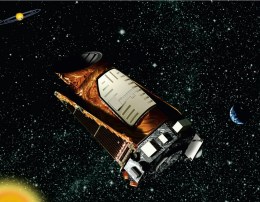Trouble in Deep Space: Wheel Malfunction Threatens Kepler Telescope’s Future | TIME.com (original) (raw)

NASA / AP
Artist's rendering of the Kepler space telescope.
At this time last year, the scientists working on Kepler, NASA’s fantastically successful planet-hunting space telescope, were ecstatic. The probe, launched in 2009, had originally been given just three and a half years’ worth of funding, but in April, 2012, the space agency decided to extend the mission by another 3.5 years. With nearly 3,000 candidate planets in the bag already, astronomers were anticipating a boatload of even more exciting discoveries.
Not so much anymore. Last Sunday, the spacecraft’s aim began to drift, sending Kepler into “safe mode” while engineers tried to figure out why. The potentially fatal diagnosis: one of the probe’s reaction wheels, crucial for holding Kepler on target, had stopped working. And if the telescope can’t stay on target, the mission is effectively over. “Unfortunately,” said John Grunsfeld, the scientist- astronaut who helped refurbish the Hubble Space Telescope during a 2009 spacewalk, during a NASA press conference, “Kepler is not in a place where I can go up and repair it.”
(PHOTOS: Deep-Space Photos: Hubble’s Greatest Hits)
That doesn’t mean engineers are quite ready to give up. “We’ll try the same things you’d do to unstuck a wheel on Earth,” said Charles Sobeck, Kepler’s deputy project manager. “We’ll try jiggling it, commanding it to move back and forth in both directions, forcing it through whatever might be holding it back.” They’ll also try restarting a reaction wheel that stopped working last year. “It could be,” said Sobeck, hopefully, “that if we wake it up, wheel 2 could just start spinning again.”
But most of the talk at the press conference was less can-do and more has-done. “We’ve had a phenomenally successful mission,” said Bill Borucki, of the NASA Ames Research Center, who first began lobbying NASA to build Kepler more than 20 years ago.
It’s hard to argue with that: Kepler’s original charter was to figure out the frequency of Earth-like planets in the Milky Way. After staring at a single representative patch of stars for four years, it’s found 280 worlds the size of Earth, or smaller, and 850 no more than twice as big — not exactly Earthlike, but still plausibly habitable if they were in the right, life friendly orbits. So far, they aren’t (most are far too hot), but a conservative extrapolation, based on what Kepler has seen, is that the galaxy could contain tens of billions of habitable, Earth-size worlds — so many that on average, the closest should be no more than about 13 light-years away, which is practically next door in cosmic terms.
(VIDEO: How to Hunt for New Earths)
By showing how truly abundant planets are in the Milky Way, Kepler has made the job of future mission designers a whole lot easier. If Earthlike worlds were rare, you’d have to build such a huge telescope to study them that it wouldn’t be worth the cost. Thanks to Kepler, probes already on the books, including the James Webb Space Telescope and the newly approved Transiting Exoplanet Survey Satellite (TESS) can be pretty much guaranteed to find habitable worlds relatively nearby, and maybe even analyze their atmosphere for signs of biological activity. “This isn’t our last exoplanet mission,” said Paul Hertz, director of NASA’s astrophysics division. It’s our first.”
Beyond that, Kepler still has at least two years’ worth of observations in the can but not yet fully analyzed. Even if it never makes another detection, there’s enough unprocessed data to keep mission scientists and astronomers around the world busy for several more years. A true Mirror Earth hasn’t been found yet, but says Borucki, “we’re pretty positive the data we already have will allow us to accomplish that. The mission is not over,” he said.
But the satellite’s operations may well be. Still, Borucki, who saw Kepler rejected four times before NASA finally gave it the go-ahead, could rightly claim that his baby had been a resounding success anyway. “Several more years of operation would have been frosting on the cake,” he said. “But we’ve had a very excellent cake.”